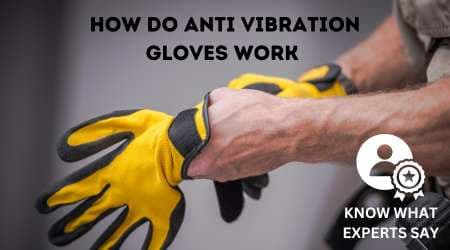Anti-vibration gloves work by absorbing and dissipating the vibrations at the source. These gloves are designed to reduce the risk of hand-arm vibration syndrome (havs), a condition that causes numbness, tingling, and pain in the hands and arms.

These gloves are made with materials that can absorb vibration, such as gel, foam, or air pockets. Anti-vibration gloves are particularly useful for individuals who work with power tools or heavy machinery. These activities can produce high levels of vibration which are harmful to the body.
Moreover, it provide an additional layer of protection against cuts, abrasions, and impact from objects. Anti-vibration gloves are essential for anyone looking to protect their hands and arms while working with power tools or heavy machinery.
What Causes Vibrations In Tools & Machinery?
Tools and machinery are essential in a variety of industries, from construction to manufacturing. However, these equipment's vibrations can pose a significant risk to workers and their wellbeing. In this section, we'll explore the sources of these vibrations and their impact on workers.
Sources Of Vibrations In Tools And Machinery
Tools and machinery can cause vibrations due to various factors, including:
- Motors: Machine's motor produces vibrations that get amplified throughout the equipment.
- Imbalance: Uneven weight distribution in the machine resulting in wobbling.
- Movement: Motion of tools and machinery results in vibrations.
- Friction & wear and tear: Excessive friction, or damage to any part leading to wear and tear, can cause the machinery to vibrate.
These factors act alone or in combination with one another.
Understanding Impact Of These Vibrations On Workers
Workers exposed to vibrations for extended periods may suffer from hand-arm vibration syndrome (havs). The symptoms manifest as loss of strength, tingling, numbness, and white fingers. In severe cases, havs can lead to permanent damage. Therefore, it's essential to reduce employee exposure to equipment vibrations to prevent this condition.
To minimize these effects, employers and individuals can minimize the vibration factors and invest in anti-vibration gloves, which will absorb most of the vibrations and protect the wearer's hand and arm.
Many things cause vibration in tools and machinery, and these vibrations can significantly impact employees working with this equipment. Using anti-vibration gloves can help reduce the damage inflicted upon the workers' hands and arms caused by vibration.
How Anti Vibration Gloves Work
Anti-vibration gloves are designed to protect the wearer from harmful vibrations and impacts that can cause injuries such as hand-arm vibration syndrome (havs) or reynaud's disease. They provide a cushioning effect that helps to reduce the impact of vibrations, hence enabling the worker to use machinery for an extended period without any adverse effects.
In this guide, we'll explain the science behind anti-vibration gloves and review the materials used to make them.
Science Behind Anti-Vibration Gloves
Anti-vibration gloves function on the principle of damping. They absorb and spread incoming vibrations, minimizing the impact on the wearer's hands. When a vibration passes through the gloves, it hits the material and converts the energy into heat. The heat produced is then absorbed or dissipated into the atmosphere.
Based on the level and frequency of the vibrations, not all materials can handle the energy conversion. Therefore, the manufacturers use materials that can absorb and dissipate the vibrations efficiently.
Some of the ways that anti-vibration gloves minimize the transmission of vibrations include:
- Use of air or gel cushioning pads helps to dampen incoming vibrations.
- Gloves' materials absorb vibrations through a process known as viscoelasticity, which converts the mechanical vibrations into thermal energy.
- When the wearer grips onto an object, the gloves cause the body to exert a force on the object. This action generates a harmonic oscillation that opposes the vibration transmitted by the tool.
Materials Used To Make These Gloves
Materials used to make anti-vibration gloves determine their efficiency and durability. Below are some of the common materials used:
- Gel: Gel is a viscoelastic material that efficiently reduces vibrations transmitted through the gloves. The gel used in gloves is usually distilled from silicone or polyurethane.
- Polymer: The most common polymer used is neoprene. It is resistant to acid, chemicals, and other corrosive substances commonly found in the work environment.
- Air cushions: Air is a good insulator and can absorb vibrations. Anti-vibration gloves with air cushioning pads reduce the impact of vibration on the hand.
- Foam: Foam is used to line the gloves and absorbs vibrations and shock.
- Leather: High-grade leather can be used to make the gloves more durable and increase wear resistance.
These materials used to make the gloves determine their comfort, durability, and effectiveness in reducing the impact of vibrations. It's necessary to choose gloves designed for specific tasks, as different work environments have unique vibration demands.
Anti-vibration gloves are essential personal protective equipment that helps to protect workers from harmful vibrations that can cause injuries. The science behind how these gloves work involves the use of materials that absorb and spread incoming vibrations or convert them into heat, reducing the impact on the worker's hands.
When choosing anti-vibration gloves, consider the work environment, the type of machinery used, and the level and frequency of vibrations to ensure that they provide the necessary protection.
Frequently Asked Questions For How Do Anti Vibration Gloves Work
How Do Anti Vibration Gloves Work?
Anti-vibration gloves work by absorbing vibrations from power tools, machinery, and hand-held devices. These gloves are made of materials consisting of layers of padding, foam, and gel that cancel out vibrations before they reach the hand and arm.
Who Should Wear Anti-Vibration Gloves?
Anti-vibration gloves are suitable for people who work with heavy machinery and power tools. Individuals with conditions like carpal tunnel syndrome, reynaud's syndrome, and other hand injuries will find these gloves helpful.
How To Choose The Right Anti-Vibration Gloves?
To choose the right anti-vibration gloves, pick gloves that reduce vibrations in the frequency range generated by the power tool or machinery. Select gloves with a reliable grip, padded knuckles, and secure wrist straps that offer excellent comfort.
Do Anti-Vibration Gloves Help Prevent Hand-Arm Vibration Syndrome (Havs)?
Yes, anti-vibration gloves can prevent hand-arm vibration syndrome (havs) by reducing the exposure time to vibration and protecting the hand muscles from fatigue, especially when used correctly and consistently.
How Often Should Anti-Vibration Gloves Be Replaced?
Anti-vibration gloves should be replaced when they start to show signs of wear and tear, such as thinning or holes in the padding. It’s best to replace your gloves every six months or when you notice any significant wear, depending on how often you use them.
Can Anti-Vibration Gloves Be Used For Other Purposes?
Yes, anti-vibration gloves can be used beyond the workplace in situations where there is prolonged exposure to vibration, such as using power tools, while biking or riding on rough terrain. Anti-vibration gloves can also be used to relieve symptoms of hand-arm vibration syndrome (havs).
Conclusion
As we wrap up our exploration of anti-vibration gloves, it's clear that these innovative products can provide significant benefits to those who work with vibrating tools and machinery. By absorbing and redirecting the energy produced by these devices, anti-vibration gloves can help prevent a range of hand injuries and disorders, including carpal tunnel syndrome and white finger disease.
In addition to their protective properties, anti-vibration gloves are also lightweight, comfortable, and easy to wear, making them a popular choice among professionals in a variety of industries. Whether you're a construction worker, mechanic, or diy enthusiast, investing in a pair of high-quality anti-vibration gloves can help keep your hands healthy and functional for years to come.
So don't wait – try out a pair today and experience the benefits for yourself!





